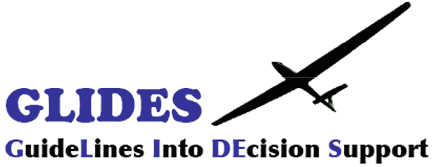GLIDES goals for Year Three are as follows:
1. Using systematic and replicable processes, continue to design, develop, implement, and demonstrate guideline-based clinical decision support. This will focus both on new guidelines and implementation partnerships, as well as enhancing and improving the CDS already produced at Yale and Nemours.
2. Recognizing the critical importance of transparently developed and clearly stated guideline recommendations for effective implementation, work closely with guideline developers to provide tools and guidance to improve guideline development and reporting processes.
3. Update the Guideline Elements Model and increase GEM adoption nationally and internationally.
4. Continue evaluation of both existing and newly developed CDS implementations.
5. Disseminate the findings and lessons learned via a variety of modalities.
Goals of GLIDES for Year One and Two were:
Translation of Decision Support Guidelines Into Systems That Improve Delivery of Health Care
Identification of preferred methods and processes for incorporating
CDS tools into EHRs and implementing them in busy practice settings:
-
The demonstration projects will involve the implementation of CDS
tools in two Certification Commission for Health IT (CCHIT) certified
health IT products. The GE Centricity system is used at all Yale practice
settings, and the EPIC Epicare system is used at Nemours.
-
ANSI Health IT Standards Panel (HITSP) standards will be
applied where available and applicable.
-
This incorporation of CDS into multiple products will demonstrate
cross-platform utility and will help to establish a wide range of best
practices useful to the health IT vendor community.
Optimization Of CDS Tools For Measuring and Improving Quality of Care
Optimization of CDS tools for measuring and improving
quality of care and providing performance feedback:
-
The GLIDES Project Plan includes a proposal for evaluating the
demonstrated work, which emphasizes assessing impact on the quality and
efficiency of healthcare delivery.
-
EHR systems in use at the demonstration sites have the capacity
to facilitate quality measurement, especially in the clinical domains being
tested.
-
Other potential benefits of CDS systems on outcomes of care,
including effects on patient satisfaction, efficiency, and quality of life,
will also be considered by the GLIDES project.
Demonstrate and Evaluate Methods Of Using CDS Elements Across Multiple Clinical Sites
The GLIDES project will demonstrate and evaluate methods of
creating, storing and replicating CDS elements across multiple clinical sites:
-
The primary setting of the proposed demonstration project testing
is ambulatory practices, in six different settings across the east coast of the
United States. These practices cover a range of different types of
ambulatory practices, enabling the project to test the generalizability of
findings and products in multiple ambulatory settings.
-
A critical component of the GLIDES project is the active
involvement of stakeholders from multiple disciplines and from multiple
healthcare groups whose needs can be addressed through CDS.
Evaluation and Dissemination Of Project Findings and Results
The GLIDES project will evaluate all critical work steps and
work products to ensure the objectives and goals of the project are met, and
will produce and distribute a series of reports consistent with AHRQ
expectations to disseminate the project.s results:
-
CCHIT recommendations for certification of information systems in
support of CDS.
-
Interim and final recommendations to the general guideline
development community, and to the developers of the specific guidelines used by
the project, on best practices in guideline development regarding CDS
translation and implementation.
-
Prepare a final report of evaluation and findings, and present
this at an AHRQ-convened conference as required by AHRQ.

